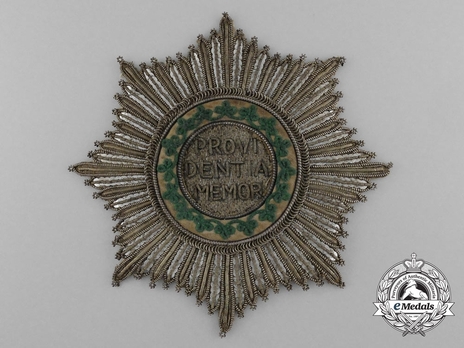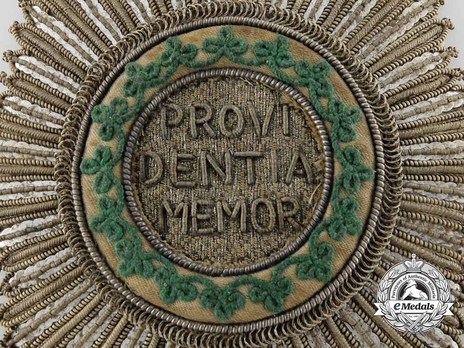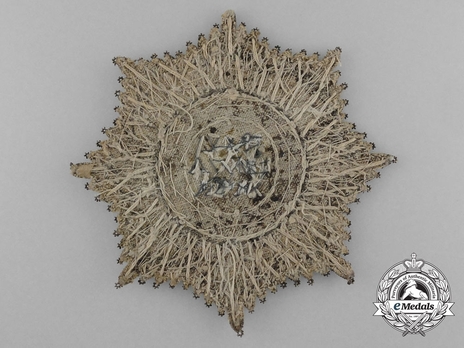Order of the Rue Crown, Breast Star (embroidered)
CATEGORY: Version
SKU: 01.SXK.0101.103.01.000
Estimated market value:



Estimated market value:
In cloth/fabric backing, embroidered in silver, silver wire and sequins, center in fabric and silver wire, of fine quality make with fine details, measuring 105 mm, very fine.
An eight-sided star, constructed of silver wire embroidery. The star is made up of several individual rays, the number of which will vary from specimen to specimen. The centre medallion is in gold with the silver inscription ‘PROVIDENTIAE MEMOR’ (‘mindful of providence’), surrounded by a circle in white silk with a dark green rue wreath. The reverse is reinforced with cardboard.
The Order of the Rue Crown was established by the first King of Saxony, Friedrich August I, under the direction of Napoleon, who was responsible for raising Saxony to a kingdom.
The order was established as the civil counterpart to the Military Order of St. Henry. It may also be known as the Order of the Crown of Saxony. It takes its name from the green floral crown of rue (crancelin) presented in the coat of arms of Saxony. The first award ceremony took place in July 1807, when King Friedrich August I and Emperor Napoleon exchanged medals in Dresden palace.
Originally, the order had a limited membership of 24 knights, but exceptions were made to include members of royalty and prestigious individuals. Royal princes were automatically admitted to the order at birth. Women were not admitted to the order.
The order was only issued in one grade, Knight. A costume was also planned for the knights, consisting of a grass-green velvet coat, skirt, waistcoat and trousers in French form of smooth drao d’or, black, lined with white atlas and embroidered with gold diamond leaves all around. A hat with a white feather, white silk stockings and a gold or gold-plated sword were also worn.
Two Knight Crosses were awarded with diamonds, one to Portuguese Prime Minister Dom Nuno José de Moura Barreto, Duke of Loulé, and one to Chancellor Otto von Bismarck. A third Knight with diamonds belongs to the crown treasure.
From its establishment in 1807 until the fall of the German Empire in 1928, the cross was only awarded 332 times. After 1918, isolated awards are known but not documented.
There may exist many varieties of the Breast Star with different compositions and sizes.
There were several known manufacturers of the order's Breast Star, including the early manufacturer Schnitzspahn from Darmstadt, Hossauer from Berlin (beginning in 1855), and Scharffenberg from Dresden (from 1896 onward). Breast Stars were made in metal from 1855 onwards.
Breast Stars including brilliants, such as diamonds, were manufactured by other unknown makers.

Comments
Sign in to comment and reply.


Scroll Top